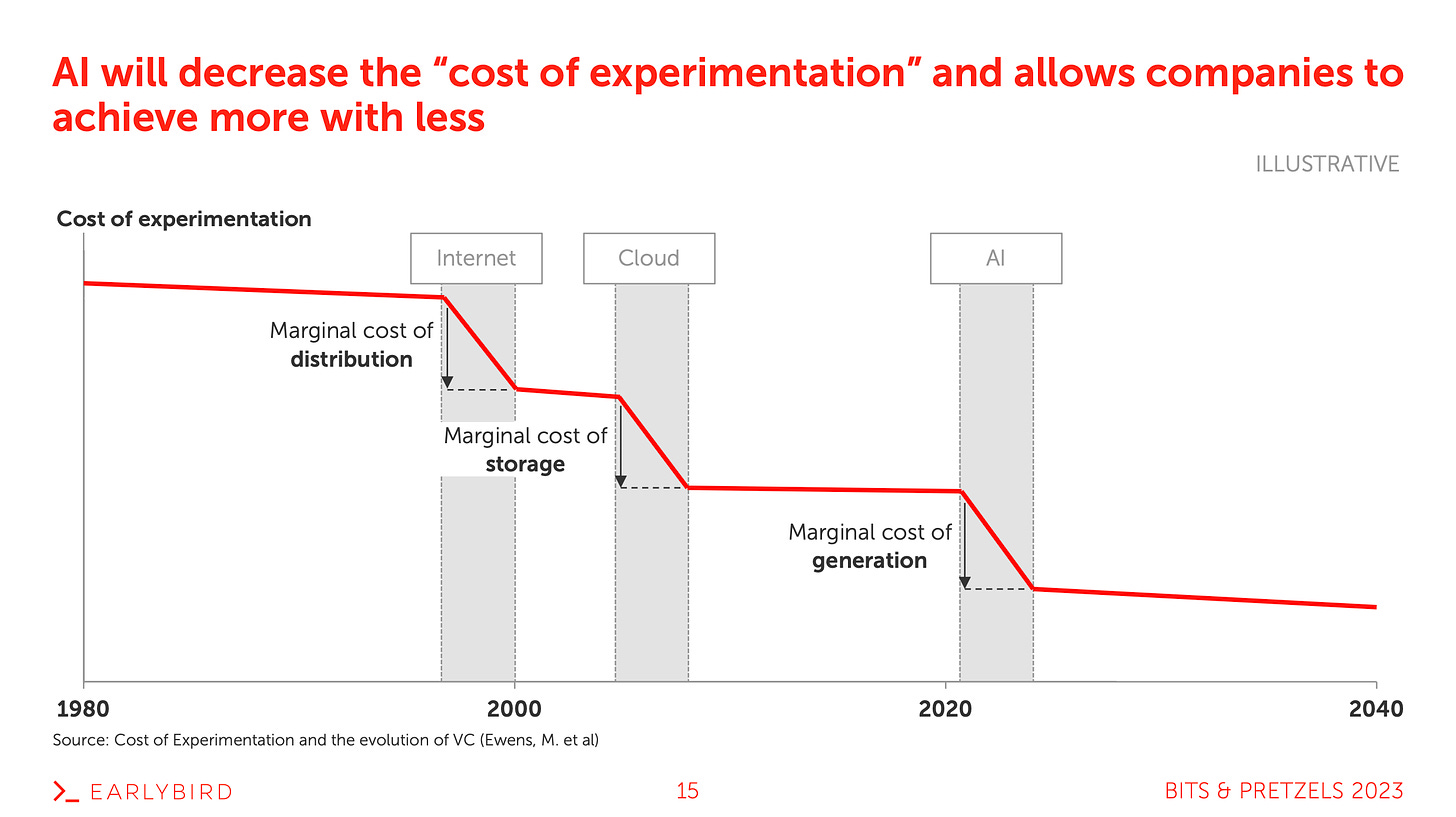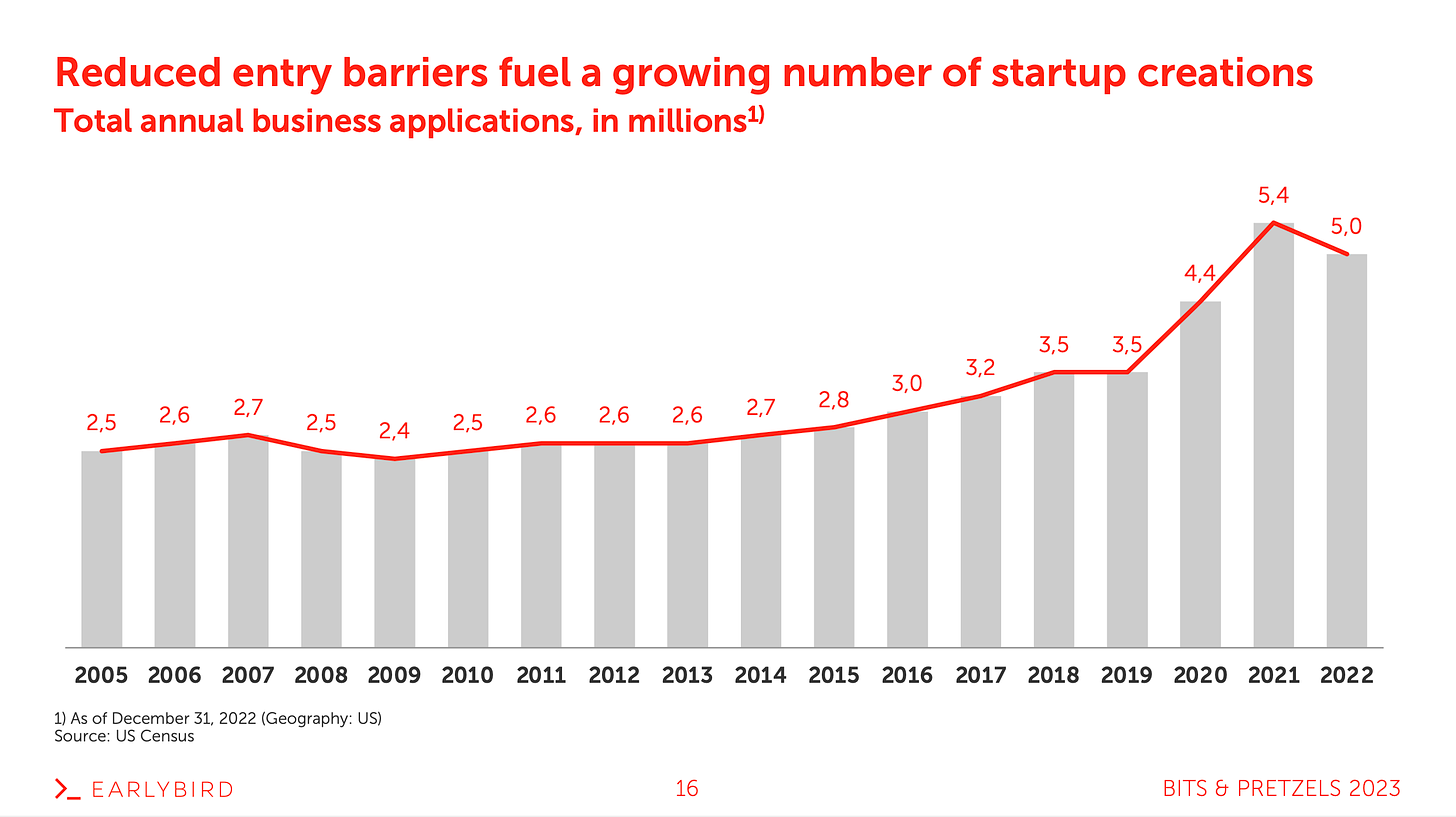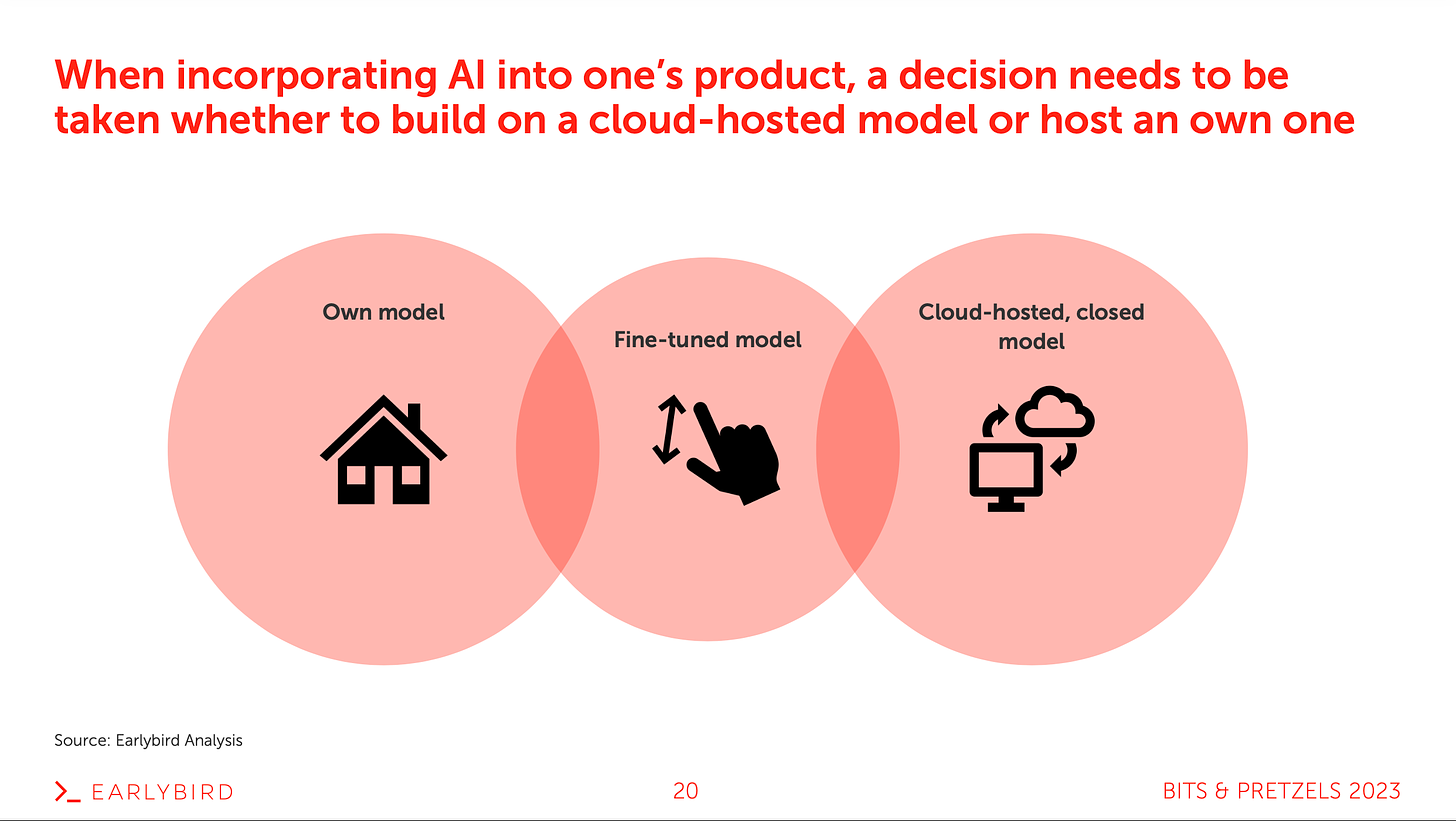How to Not Miss the AI Train: Essentials You Need to Know
DDVC #55: Where venture capital and data intersect. Every week.
👋 Hi, I’m Andre and welcome to my weekly newsletter, Data-driven VC. Every Thursday I cover hands-on insights into data-driven innovation in venture capital and connect the dots between the latest research, reviews of novel tools and datasets, deep dives into various VC tech stacks, interviews with experts, and the implications for all stakeholders. Follow along to understand how data-driven approaches change the game, why it matters, and what it means for you.
Current subscribers: 13,713, +157 since last week
Brought to you by VESTBERRY - The Portfolio Intelligence Platform for Data-driven VCs
We are opening early access to our Affinity Integration! What value does it bring to VCs? In short, it allows you to become more data-driven by combining your relationship and portfolio data to discover hidden connections and insights. For example, you can easily identify influential stakeholders within your portfolio to discuss secondaries, explore co-investment opportunities, or share investment plans. And there's more to uncover! Early stage has limited spots, so be among the first to sign up.
TL;DR
Perfect AI storm due to “magic triangle” of intelligent algorithms, powerful compute, and large-scale availability of data
I share 2 frameworks to assess AI: 1) Onion framework to understand terminology and 2) value chain framework to understand different propositions as well as full-stack/verticalized versus horizontal
AI will reduce the cost of experimentation, more specifically the marginal cost of generation, and thus allow companies to achieve more with less
Reduced entry barriers will increase new startup creation, eventually increasing cash demand more broadly across the startup ecosystem
Increased capital demand together with current cash shortage led to strong buyer’s market but will hopefully bounce back to more balanced dynamic
Companies need to access the potential of AI for 1) their workforce and 2) their own product, a simple framework below
Digitization of VC is still at day 0, providing a huge opportunity for first-movers leveraging data & AI to generate alpha, more details via
—
Last week, I was invited to give two keynotes at Bits & Pretzels, one of the leading startup conferences in Europe. My Sunday session was all about “The Future of Startups & VC: Augmenting Humans with AI”, a topic that’s close to my heart and the essence of this newsletter. Subsequently, the Monday session “How to Not Miss the AI Train: Essentials You Need to Know” was intended to double-click on the previous day and provide a more comprehensive rundown of the recent AI hype, frameworks to properly access AI opportunities as well as a perspective on the impact of AI on our economy, startups, and us as VC investors.
Unfortunately, I needed to cancel the Monday session on short notice due to my very own Earlybird 🐣🤩 surprise. I appreciate that many of you were at the stage when it was canceled (thanks for your kind messages), so I’m happy to share the presentation with you today. Below, you’ll find the most relevant slides including key talking points.
“Magic Triangle of AI”: Algorithms + Compute + Data
It feels that the perfect AI storm has just begun, yet in reality, it has been 70+ years in the making. Only with intelligent algorithms (starting in the 50s), powerful computing (starting in the 90s but waiting for its breakthrough in the 2010s via parallel computing and GPUs), and broad availability of data (“data is the new oil”); the so-called “Magic Triangle of AI”; AI started to become reality.
While the actual epicenter of the AI boom was probably the discovery of attention mechanisms via the “Attention is all you need” paper in 2017, I’m convinced that 2022 will be remembered as the year of breakthrough in AI due to the launch of ChatGPT. ChatGPT and its ability to prompt LLMs via natural language (instead of code) removed significant friction and led to widespread adoption across prosumers.
How to make sense of AI in a structured way – 2 helpful frameworks
Following the craze of the past year and engaging in a variety of conversations around AI, I couldn't help but notice a common trend—many people seem to confuse the fundamentals and mix up various concepts regarding AI. It became evident that amidst the excitement and buzz surrounding AI, there is a need for clear and simple frameworks to help demystify this complex field.
As described in this “AI Cheat Sheet” post, I’m a big believer in simplifying frameworks to make sure we speak the same language. My two favorites are below.
The “Onion Framework” for terminology
The “Value Chain Framework” for different propositions
What’s holding us back now?
By now it’s pretty obvious that compute infrastructure is the key bottleneck to scale AI. Seemingly unlimited demand faces restricted supply. The result? Nvidia as the leading AI-GPU provider became one of the most valuable companies after posting year-over-year sales growth of 101%, to $13.5 billion for the three months that ended in July — a new record for the company. Of course, this also engages geo-political attention.
The impact of AI on our economy, the startups we invest in, as well as ourselves as VCs
What’s ahead?
It’s very much a crystal ball but I strongly believe that Amara’s law will hold true for AI as for other technological shifts in the past:
“We tend to overestimate the effect of a technology in the short run and underestimate the effect in the long run.” - Roy Charles Amara
Those are obviously just a few of many predictions that I anticipate as an impact of AI. I’m particularly excited about the cost of experimentation though. Let’s look at this in a bit more detail.
The impact of AI on the cost of experimentation
I wrote about “The impact of AI on the cost of starting and running a business” earlier this year and we started seeing the first data points for this trend. The cost of experimentation is defined as the resources required to achieve a specific milestone, e.g. product-market fit or 1M ARR, and clearly, we can see that startups begin to achieve more with less.
Ewens, Nanda, and Rhodes-Kropf wrote an interesting paper in 2018 about the impact of technological platform shifts on the cost of experimentation. More generally they find that technological innovation allows companies to achieve more with less. I strongly believe that this will hold true for AI too.
The internet reduced the marginal cost of distribution, the cloud reduced the marginal cost of storage, and AI is about to reduce the marginal cost of generation. Surely, we can add the steam engine and mobile too, but I wanted to limit the above slide to the major technologies relevant in the context of AI.
In line with a decreasing marginal cost of generation, I see two potential scenarios in the context of startup funding:
Funding rounds stay the same in size, allowing companies to achieve significantly more, faster. Input same, output up. This would push expectations for the individual stages up, e.g. it could mean that Series A SaaS is no longer 1M ARR but 2M ARR
Funding rounds become smaller in size, allowing companies to take out the same risks as before, faster. Input down, output same.
Looking for example at the impact of the cloud on the size of funding rounds, we can see that historically round sizes went in just one direction: up. So scenario 1. seems the most likely: Funding rounds will stay unchanged (or even go up) and companies will achieve more significant outcomes with the help of AI, meaning that they can take out more risk per stage than before.
On a more macro level, reduced entry barriers historically fueled new startup creation. While the line was approximately constant over decades, we can see a few exogenous shocks that pushed the absolute level up. These step changes were likely driven by technological innovation, as highlighted in the referenced paper above. Of course, we need to account for macro factors like interest rates, yet I’m convinced that we will see more companies being founded - driven by lower entry barriers through AI.
Constant (or even increasing) size of funding rounds + growing number of startup creations = increased cash demand
Switching from the demand side of startups to the supply side of VCs and LPs, we see that interest hikes and public market corrections in 2022 temporarily shut the IPO window. Hereof, exit opportunities suddenly disappeared and investors could not cash out. The resulting liquidity shortages together with denominator effects for a broad range of LPs led to reduced capital supply for VCs.
Assuming that VCs are an intermediary between LPs and startups, this also means limited cash for startups. Yes, we need to price in dry powder (=reserves) and time lags, but the forward-looking investment mindset defines deployment speed and aggressiveness. Put into a simple metric of cash demand by startups divided by cash supplied by VCs across early-stage, growth, and late-stage, we see a steep increase in this demand-supply ratio starting in Q2-2022.
Said differently, this means that we moved from a balanced market pre-2020 into a seller’s market in 2021 (i.e., the crazy hype that allowed startups to raise at any terms, sometimes without proper DD) into a more cash-constrained buyer’s market as of Q3 2022. On average, investors have been dictating the terms for more than a year now but interpreting recent market sentiment and a potentially re-opening IPO window, I expect we’ll see a bounce back towards a more balanced ratio soon.
What does this mean for you as a founder or operator?
Well, on the most basic level, you need to think about leveraging AI to become more efficient and add features to your product that offer you an unfair advantage. I’ve written about this in my previous articles, so will keep it short here.
What does this mean for you as a VC investor?
Finally, the arc of suspense gets to its max. Having discussed the history of AI, why we’re facing the perfect AI storm, how we can access AI opportunities, what it means for our economy, and the startups we invest in, we can finally look at ourselves. VCs are best to criticize their founders, yet rarely question themselves. Case in point: VC is most likely one of the least digitized industries. How can it be that the backers of the most disruptive businesses themselves operate like in the 1950s?
… and the presentation was intended to end with a detailed case study about how we leverage data-driven approaches and AI within our proprietary platform called “EagleEye” at Earlybird. Well, after some back and forth, I decided to keep this part for another talk and exclude it here ;)
Stay driven,
Andre
Thank you for reading. If you liked it, share it with your friends, colleagues, and everyone interested in data-driven innovation. Subscribe below and follow me on LinkedIn or Twitter to never miss data-driven VC updates again.
What do you think about my weekly Newsletter? Love it | It's great | Good | Okay-ish | Stop it
If you have any suggestions, want me to feature an article, research, your tech stack or list a job, hit me up! I would love to include it in my next edition😎





















Great post!